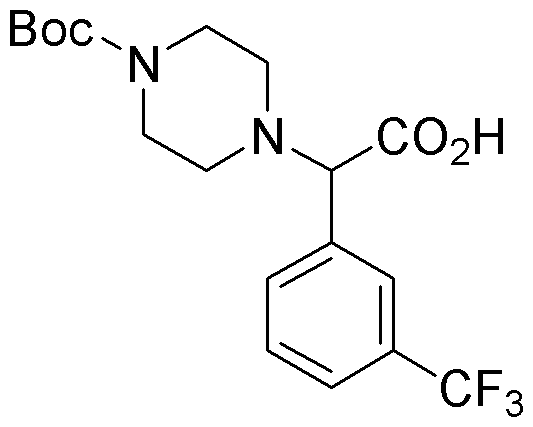2-(4-Boc-piperazinyl)-2-(3-trifluoromethylphenyl)acetic acid is widely utilized in research focused on:
- Pharmaceutical Development: This compound serves as a key intermediate in the synthesis of novel pharmaceuticals, particularly in developing drugs targeting neurological disorders due to its piperazine structure, which enhances bioactivity.
- Medicinal Chemistry: It is employed in the design of new therapeutic agents, offering researchers a versatile scaffold for modifying and optimizing drug candidates, especially in the field of anti-depressants and anxiolytics.
- Biochemical Research: The compound is used in studies investigating receptor interactions and enzyme activities, providing insights into biological mechanisms and potential therapeutic targets.
- Material Science: Its unique chemical properties allow it to be incorporated into polymers and coatings, enhancing material performance in various applications, including drug delivery systems.
- Analytical Chemistry: This chemical is utilized as a standard in analytical methods, aiding in the development of assays for detecting related compounds in biological samples, thus facilitating research in toxicology and pharmacokinetics.
General Information
Properties
Safety and Regulations
Applications
2-(4-Boc-piperazinyl)-2-(3-trifluoromethylphenyl)acetic acid is widely utilized in research focused on:
- Pharmaceutical Development: This compound serves as a key intermediate in the synthesis of novel pharmaceuticals, particularly in developing drugs targeting neurological disorders due to its piperazine structure, which enhances bioactivity.
- Medicinal Chemistry: It is employed in the design of new therapeutic agents, offering researchers a versatile scaffold for modifying and optimizing drug candidates, especially in the field of anti-depressants and anxiolytics.
- Biochemical Research: The compound is used in studies investigating receptor interactions and enzyme activities, providing insights into biological mechanisms and potential therapeutic targets.
- Material Science: Its unique chemical properties allow it to be incorporated into polymers and coatings, enhancing material performance in various applications, including drug delivery systems.
- Analytical Chemistry: This chemical is utilized as a standard in analytical methods, aiding in the development of assays for detecting related compounds in biological samples, thus facilitating research in toxicology and pharmacokinetics.
Documents
Safety Data Sheets (SDS)
The SDS provides comprehensive safety information on handling, storage, and disposal of the product.
Product Specification (PS)
The PS provides a comprehensive breakdown of the product’s properties, including chemical composition, physical state, purity, and storage requirements. It also details acceptable quality ranges and the product's intended applications.
Certificates of Analysis (COA)
Search for Certificates of Analysis (COA) by entering the products Lot Number. Lot and Batch Numbers can be found on a product’s label following the words ‘Lot’ or ‘Batch’.
Número de catálogo
Número de lote/lote
Certificates Of Origin (COO)
This COO confirms the country where the product was manufactured, and also details the materials and components used in it and whether it is derived from natural, synthetic, or other specific sources. This certificate may be required for customs, trade, and regulatory compliance.
Número de catálogo
Número de lote/lote
Safety Data Sheets (SDS)
The SDS provides comprehensive safety information on handling, storage, and disposal of the product.
DownloadProduct Specification (PS)
The PS provides a comprehensive breakdown of the product’s properties, including chemical composition, physical state, purity, and storage requirements. It also details acceptable quality ranges and the product's intended applications.
DownloadCertificates of Analysis (COA)
Search for Certificates of Analysis (COA) by entering the products Lot Number. Lot and Batch Numbers can be found on a product’s label following the words ‘Lot’ or ‘Batch’.
Número de catálogo
Número de lote/lote
Certificates Of Origin (COO)
This COO confirms the country where the product was manufactured, and also details the materials and components used in it and whether it is derived from natural, synthetic, or other specific sources. This certificate may be required for customs, trade, and regulatory compliance.


